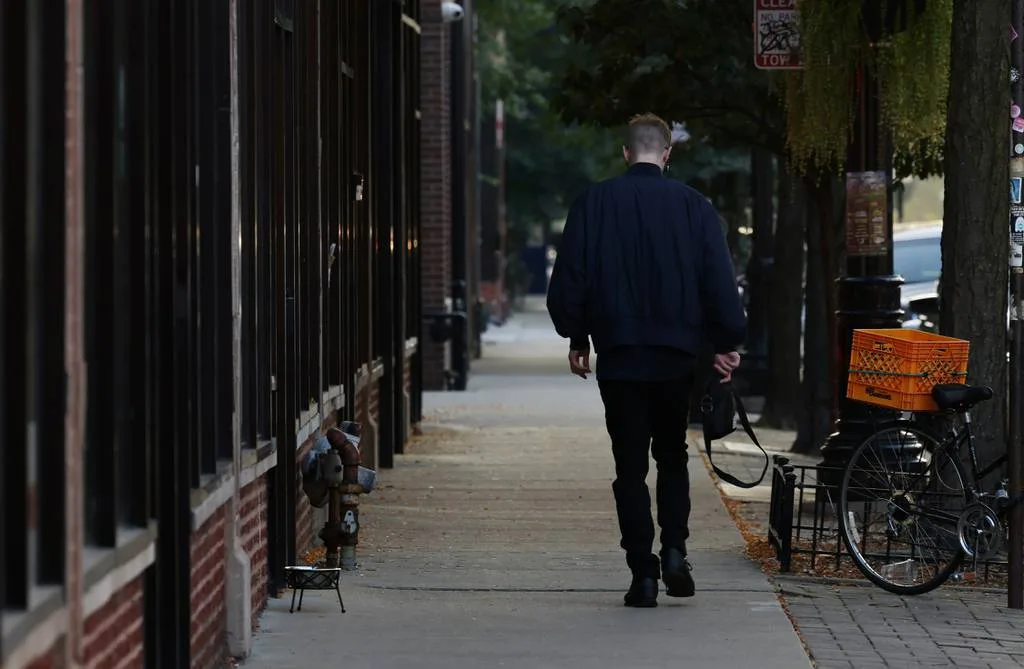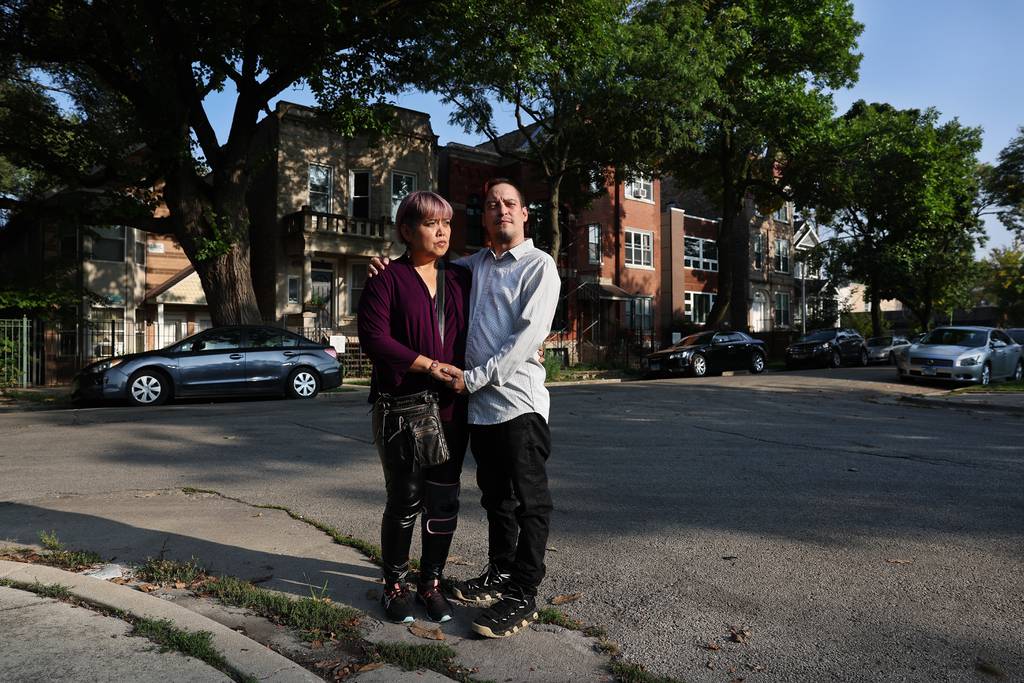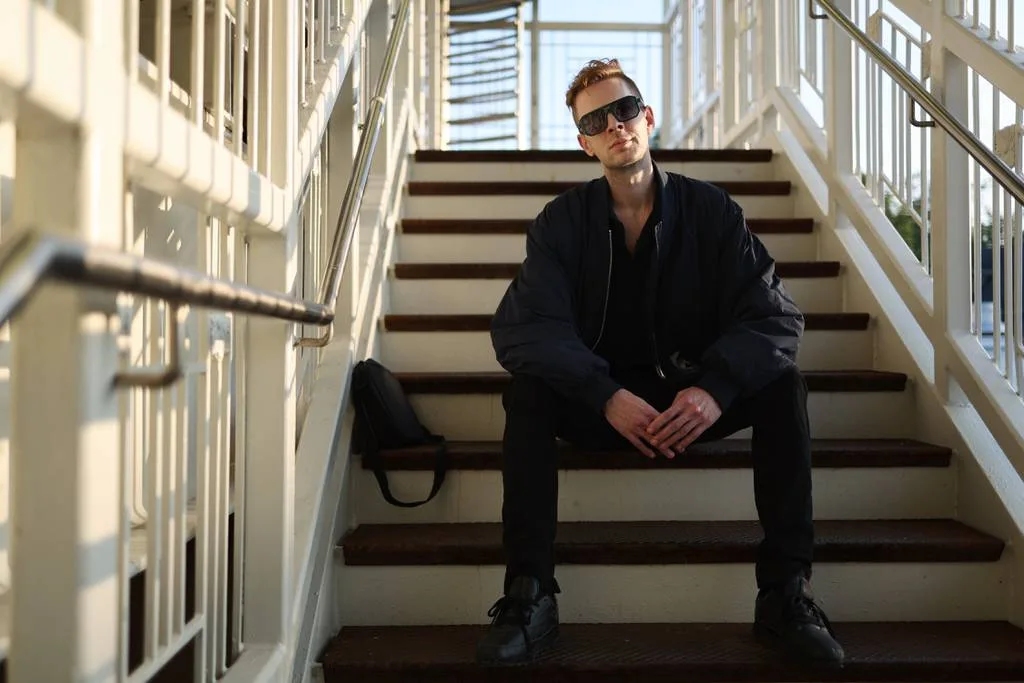The call that came over the police radio Monday morning was startling if familiar by now: Two men in a stolen car committing robberies at gunpoint across Chicago’s South Side.
Within a span of minutes, the robbers held up employees at two discount stores and stole wallets and other belongings from pedestrians on the street. All of the victims described having guns pointed in their faces, according to police and court records. One was knocked to the ground.
This time, police quickly caught a 25-year-old suspect after an alert witness saw two men matching the robbers’ description running from a stolen Kia with bags in their hands on South Carpenter Street, according to court records.
But it’s a drop in the bucket.
In the days before and after those robberies, waves of other stickups were happening around the city, including a driver accosted by rifle-toting teens as he was unloading his car in Bucktown, a woman carjacked at gunpoint in Rogers Park, students walking near DePaul University’s Lincoln Park campus and a bar worker mugged after leaving work in the West Loop.
While armed robberies are nothing new in Chicago, a disturbing new pattern has emerged in recent months where crews of robbers — many of them juveniles — toting high-powered weapons go on crime sprees, robbing or carjacking multiple victims in a matter of minutes, often using stolen cars and dressed head to toe in black.
They seem to be constantly one step ahead of authorities. Before police can even respond to one scene, more have popped up, leaving dozens upon dozens of victims in their wake.
The vast majority of the robberies have gone unsolved, producing a series of negative headlines for Mayor Brandon Johnson and his newly minted police Superintendent Larry Snelling, even as homicides and some other violent crime metrics are dropping.
The sheer volume of robberies has left aldermen frustrated and many residents of frequently targeted neighborhoods frightened. At a community meeting Monday evening in Humboldt Park, local leaders, anti-violence workers and police officials attempted to address area residents’ safety concerns and more fully explain the challenges.
“I think everyone is so freaked out, who’s lived in this area for a long time, because of the random and brazen nature of what’s happening right now,” said Rod O’Connor, who has lived in the Humboldt Park area for more than two decades. “I want the next generation of shooters to not become shooters, but the generation right now is what we’re all freaked out about and why I worry about my kid riding her bike two blocks from her house.”

Some have pointed to a lack of a sense of urgency from the Johnson administration.
“The City has a responsibility to protect all Chicago residents in every Chicago community. Our administration and the Chicago Police Department are fully committed to deploying strategies that will bring justice to victims of violent crimes and hold offenders accountable,” the mayor’s office said in a written response for this article. “The appointment of Superintendent Larry Snelling is just the latest step in using the full force of government to keep residents safe from harm.”
To try to thwart the growing problem, Chicago police have used an array of tools including helicopters, phone tracking, physical surveillance and fingerprint analysis to try to catch the robbery crews in real time and develop the evidence to make charges stick in court, sources told the Tribune.
Federal agencies have provided an assist with air support and real-time tracking of phones when possible, and state police have proved helpful in chasing suspects, since Chicago Police Department policies severely restrict when its officers can pursue, according to sources.
That effort has led to the recent busts of several armed robbery crews believed to be responsible for dozens of holdups around the city. One of the suspects arrested in the South Loop after a robbery spree over Labor Day weekend had recently been acquitted in a murder case and was free on bond on new charges of fentanyl trafficking, records show.
But even when they do make arrests, police are having trouble getting enough evidence to file charges. The crimes leave little in the way of physical evidence. Victims mostly are unable to make positive identifications. The cars used in many of the crimes are stolen or have bogus plates.
“There’s trouble identifying some of the offenders, we’re using technology to try to catch a lot of these offenders as well,” Chicago police Sgt. Michael Edens, of the Northwest Side’s Shakespeare District, told the approximately 100 attendees at Monday’s meeting.
Meanwhile, the man arrested in the South Side robberies on Monday, Drevon Grant, was charged with four counts of armed robbery.
During a court hearing Wednesday, Cook County prosecutors revealed Grant was out on bond in an assault case where he allegedly threatened to shoot a Walmart security guard three months ago, court records show.
A judge ruled Grant was a danger to the community and ordered him held without bond, records show.
Through mid-September, robberies had increased by 24% on the year, according to CPD data. Motor vehicle thefts — most often involving Hyundai and Kia models — are up 86%, with more than 21,000 incidents reported so far this year.
Edens said many of the suspects involved in the robberies are juveniles. Those who are arrested are often sent back to parents or guardians, while some of those charged as adults are being placed on electronic monitoring, he said.
Ald. Jessie Fuentes, 26th, told the crowd at the meeting the juvenile justice system is not equipped to steer at-risk youth away from criminal behavior. She highlighted the need to better understand how young people are accessing guns and getting involved in crime.
The number of robbery victims in her Near Northwest Side ward, which covers portions of Humboldt Park and Bucktown, has risen 361% compared with 2022, according to police data. Fuentes hopes to fight the rise with increased visibility in high-crime areas from violence prevention groups, block clubs and police, she told the Tribune. But the problem must be addressed long term with a focus on rectifying years of disinvestment in certain neighborhoods, she said.




“We have to ask ourselves, when someone is robbing someone, what are they seeking to achieve?” Fuentes said.
Jose Pizarro, director of safe streets for the Alliance of Local Social Organizations, told those gathered that youth are driven to criminal activity by a feeling of desperation, and the COVID-19 pandemic only made the situation worse.
“We have young people who are in survival mode, and the reason they’re in survival mode is because they feel they have nowhere else to go. They feel they have no future,” Pizarro said.
Robberies and motor vehicle thefts are indeed a citywide problem, and those crimes are felt even more frequently in less-affluent neighborhoods, though those cases attract far less media attention.
“The focus has been on incidents that occur on the North Side, and yet we see the victimizations are actually still more concentrated on the South and West sides,” said Roseanna Ander, director of the University of Chicago’s Crime Lab.
Police data analyzed by the Crime Lab shows dozens of neighborhoods across Chicago are seeing large spikes in robberies this year. West Side neighborhoods have been hit particularly hard, including jumps of 228% in Humboldt Park and 176% in the Lower West Side.
The victims range in age, though Black and Hispanic people make up the vast majority of those targeted in the crimes, city data shows.
In Ald. Scott Waguespack’s 32nd Ward, robberies have risen 67% this year. The attacks seem to be more violent and brazen, he told the Tribune.
“They’re not only robbing somebody, but then they’re beating them either into submission or beating them after the fact,” Waguespack said.
After a man was brutally robbed in Bucktown early Monday afternoon, Waguespack drove around the neighborhood to “be another set of eyes” for police. Viral surveillance footage showed the attackers sucker-punching a man who had been walking in an alleyway while eating pizza. They pulled him to the ground, kicked him, stomped on him and tore his backpack away.
Police later arrested several suspects who they believe might have committed the attack, Waguespack said. But a perceived lack of repercussions has emboldened would-be robbers, he argued.
He said his many City Council colleagues have failed to sufficiently denounce the rising robberies and pinned blame on county prosecutors for not bringing charges in some cases and judges for not delivering strong sentences in others. Waguespack called on the mayor to find more immediate solutions and argued crime can’t be addressed only with “long-term” plans.
“The problem is there have been too many elected officials failing to do their duty to keep the worst of people off the streets,” Waguespack said. “North Side, South Side, West Side. It’s bad all around. People are angry.”
While the City Council approved Snelling as police superintendent Wednesday, Ald. Jeanette Taylor, 20th, said the new chief had a grasp on the forces that lead people to rob others. She called it “funny” to hear other aldermen complaining of robberies in their wards. Robberies are up 18% in her South Side ward.
“They’ve been doing that in our community for years,” she said.
On the last weekend in August, a multijurisdictional task force was on to a robbery crew suspected of committing dozens of armed heists over several days.
The crew was brazen but also used a variety of means to avoid capture, according to police sources. They used a “clean” car with valid license plates to drop people off at stolen cars they have ready at strategic locations. The crew then used the stolen car to commit as many robberies as they could in a very short period of time before ditching it in a new spot and getting back in the clean car.
When the assailants showed up at area ATMs to try to withdraw cash from their victims’ cards, they often had changed clothes so the descriptions given by the victims did not match.
Police got a break after a cellphone believed to belong to one of the crew members was identified and federal agents helped the task force track them as they drove around the city.
Shortly after 3 a.m. on Aug. 26, the task force decided to move in. A police report stated the team of officers investigating a “city-wide pattern” of robberies had a beige Mercury Mountaineer under surveillance and attempted to stop the vehicle after seeing one of the suspects, 18-year-old Jacquez Adams, get into the rear passenger seat near Congress Parkway and California Avenue.
After the driver of the car rammed into a police vehicle, all of the occupants, including Adams, bailed out and tried to run, according to the report.
Police found an arsenal of weapons inside the Mountaineer, including a loaded rifle with a 7-inch barrel leaned up against the seat where Adams had been sitting, Cook County Assistant State’s Attorney Danielle Levin told a judge in bond court the next day, according to a transcript of the hearing.
All of the occupants denied knowing the guns were in the car, according to the police report, which lists 27 Chicago police officers and detectives and an Illinois State Police trooper as participating in the arrest.
Adams, of the 3100 of West Fillmore Street, was charged with a felony count of unlawful use of a weapon in a vehicle, as well as a misdemeanor count of reckless conduct — but he was not charged with any of the robberies.
At the time of his arrest, Adams, who was twice convicted of carjacking as a juvenile, was just a few weeks into a two-year probation sentence for possession of a stolen motor vehicle, his first case as an adult, court records show.
Cook County Associate Judge Ankur Srivastava ordered Adams held without bond on the alleged violation of his probation.
“I’ll note you were not the driver and you’re not charged with anything else,” Srivastava said.
Meanwhile, three other male teens arrested that night were charged with only minor offenses, records show. The driver of the car, a 19-year-old woman, was released without any charges, records show.
About a week after those arrests, Chicago police were on the trail of another armed robbery crew over Labor Day weekend suspected in a series of stickups stretching from the South Side to West Town, according to police.
One victim was loading a moving truck with relatives at 48th Street and Calumet Avenue when the gunmen rode up in a car, jumped out wearing masks and robbed them at gunpoint. Another occurred on the 1800 block of West Race Avenue, where the teens approached a victim who was walking out of his short-term rental apartment.
In all, there were seven separate robberies involving 11 victims ages 23 to 60 before police caught up with the teens in the South Loop area on Saturday afternoon Sept. 2, where they were all arrested within blocks of each other.
Key to the apprehensions in that case was a Chicago police helicopter that surveilled the suspects as they ran, sources said.
Prosecutors charged three boys, 15, 16 and 17, as juveniles with multiple counts of armed robbery, attempted armed robbery, and unlawful use of a weapon, according to police. A fourth suspect, 20, was initially released after prosecutors declined charges, a source said.
After the arrests, investigators have continued to work the case, obtaining warrants for the phones that were recovered both in the car and near the scene to try to glean how the teens were communicating and whether anyone else was involved.
One of those warrants came back to the 20-year-old who had been released, a source said. But court records show he is a known member of the Black Souls street gang and was acquitted in a bench trial in November of first-degree murder charges stemming from the 2017 killing of an alderman’s nephew on the West Side.
Two months after being acquitted, he was arrested in a violent carjacking after a Chicago police task force, aided by a U.S. Department of Homeland Security helicopter, chased him and four suspects from a stolen Audi to an apartment building in the 1900 block of South Troy Street, court records show.
That case was dropped by Cook County prosecutors in June.
As the robbery sprees continue to mount, so have the stories of victims, everyday Chicagoans just walking to the train, going to class, driving to work.
Richard Pallardy was attacked walking toward a CTA station after midnight Saturday morning. He wore no headphones on the vacant River North street, but still didn’t hear the person who came up behind him to hit him, knocking him down face first.
“The next thing I knew, I was on the ground,” he told the Tribune.
A group of attackers flipped Pallardy over to get his belongings, leaving him with cuts across his body, he recalled. They took his phone. They grabbed his bags. They rifled through his pockets, tearing his shorts in the process.




He came to later and got up, calling police with the help of someone who had heard about the attack. It took 15 minutes for officers to arrive, Pallardy estimated.
“Taking 15 minutes to get to someone who was robbed and assaulted in a major downtown neighborhood is not acceptable,” he said.
The cuts across his body hurt. Frustration has mounted as he replaced locks, ID cards and a phone. Slow responses from aldermanic offices, a lack of media coverage and limited contact with the police have made him feel overlooked.
But Pallardy’s main emotion, he said, is anger. He appreciates the concern many progressive politicians have in addressing systemic issues underlying crime, but said that focus has at times prevented needed immediate action.
“Privileging the rights of perpetrators over victims, I think we’re reaping the consequences of that,” he said.
The fear is also present at DePaul University, where several students have been victimized in each of the last three weekends.
The mounting attacks, where groups of thieves often brandishing guns pull up in cars to demand property, has sparked alarm among students and their families, said Gene Zdziarski, vice president for student affairs at DePaul.
“It’s over in a few minutes, but it’s certainly very traumatic for the students,” Zdziarski told the Tribune.
The university is adding public safety officers and patrols, expanding escorts for students and asking the campus community to keep university ID cards on hand, he said.
At the Humboldt Park meeting Monday, residents exasperated by crime urged elected officials to change course to take questions from the crowd.
That’s when Eloisa Luistro-Rodriguez, who was carjacked along with her husband in late May, rose to speak. She took the mic because her husband, Gabriel Rodriguez, wasn’t sure if he could effectively express their call-to-action.
He suffered a traumatic brain injury during the attack at North Rockwell Street and West Crystal Street after being hit with a gun.
The couple said they were glad elected officials heard their story, but were less confident in what they heard from the panelists.
They want to see more visibility, including cameras, lights, police, violence interrupters.
“I need to know that we’re going to be safe,” she said. “I don’t feel safe.”


